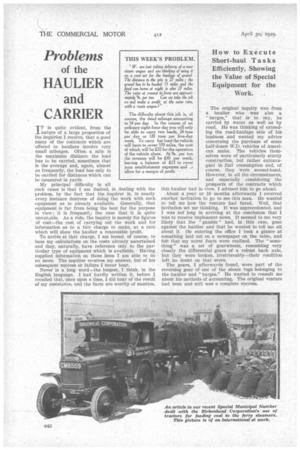Problems
Page 76

Page 77

If you've noticed an error in this article please click here to report it so we can fix it.
of the
HAULIER and CARRIER
IT is quite evident, from the nature of a large proportion of the inquiries Ireceive, that a good many of the contracts which are offered to hauliers involve very small mileages. Often a mile is the maximum distance the load has to be carried, sometimes that is the average and, again, almost as frequently, the load has only to he carried for distances which can be measured in yards.
such cases is that I am limited, in dealing with the problem, by the fact that the inquirer is, in nearly every instance desirous of doing the work with such equipment as is already available. Generally, that equipment is far from being the best for the purpose in view; it is frequentlj the case that it is quite unsuitable. As a rule, the inquiry is merely for figures . of cost—the cost of carrying out the work and for information as to a fair charge to make, at a rate which will show the haulier a reasonable profit.
To arrive at that charge, I am bound. of course, to base my calculations on the costs already ascertained and they, naturally, have reference only to the particular type of equipment which is available. Having supplied information on those lines I am able to do no more. The inquirer receives my answer, but of his subsequent success or failure I never hear.
Never is a long word-.—the longest, I think, in the English language. I had hardly written it, before recalled that, once upon a time, I did hear of the result of my assistance, and the facts are worthy of mention.
The original inquiry was from a haulier who was also a " bargee," that is' to say, he carried by water as well as by road. He was thinking of extending the road-haulage side of his business and wanted my advice concerning the purchase of some half-dozen W.D. vehicles of Atneri-. can make. The vehicles themselves were of particularly sturdy construction, but rather extravagant in fuel consumption and, of .course, they were second-hand. However, in all the circumstances, and especially considering the prospects of the contracts which this haulier had in view, I advised him to go ahead.
About a year or 18 months afterwards 1 received another invitation to go to see this man. He wanted to tell me how the venture had fared. Well, that invitation set me thinking. It was unprecedented, and I was not long in arriving at the conclusion that I was to receive unpleasant news. It seemed to me very likely that the " gamble " had, in this case, gone against the haulier and that he wanted to tell me all about it. On entering the office I took a glance at something laid out on a newspaper on the table, and felt that my worst fears were realized. The " something" was a set of gearwheels, resembling very closely the differential gears of a robust back axle, but they were broken, irretrievably—their condition left no doubt on that score.
The gears, I afterwards found, were part of the reversing gear of one of the steam tugs belonging to the haulier and "bargee." He wanted to consult me about his methods of accounting. The original venture had been and still was it complete success. The moral of the story is that there is, after all, nothing to fear from supplementary questions, and I should 'really like those to whom I send answers to queries to let me imow, sometimes, how they get on, even if it involves me in answering further questions, or, perhaps, in paying visits.
I started this article by referring to short hauls. I nave,hardly space to do more than mention the actual case which brought that matter forcibly to my mind. I have just been given the facts about a particularly short-distance haulage job carried out by a London haulier.
A Typical Short-haul Job.
A ship load of grain-220 tons—had to be moved from the ship-side to the warehouse 300 yards away, the grain being stored in sacks. The vehicle employed had a capacity of 2 tons only, so that 110 journeys bad. to be made. The total distance, consequently, was 374 miles. The work was completed in 124 working hours, which is at the rate of 17.6 tons per hour. The petrol consumed was four gallons, How was it done?
The commission was executed by a S.D. Freighter, with three special-type demountable bodies which were capable of being automatically discharged from Ole chassis and remounted thereon by the unaided effort of the driver. All the time the Work was going forward there was one body at the side of the ship being loaded, another at the warehouse unloading and the third, either empty or full, was being conveyed to or from the ship.
How Special Equipment, _Helps.
That is the way to carry out a short haul, but very few hauliers are equipped to do it after that fashion, or have capital to invest, at short notice, in the equipment necessary ' for the purpose. Very few, indeed, are in a position to purchase the best equipment for any special job, and that is one reason why the big concerns, with resource available or such work, have the advantage. If there be a moral to this story, and I think there is, its discussion will have to be postponed until some other time, in order that it may be dealt with in full. S.T.R.




























































































































